Android, the world's most popular mobile platform
Android powers hundreds of millions of mobile devices in more than 190 countries around the world. It's the largest installed base of any mobile platform and growing fast—every day another million users power up their Android devices for the first time and start looking for apps, games, and other digital content.
Android gives you a world-class platform for creating apps and games for Android users everywhere, as well as an open marketplace for distributing to them instantly.

Android growth in device activations
Global partnerships and large installed base
Building on the contributions of the open-source Linux community and more than 300 hardware, software, and carrier partners, Android has rapidly become the fastest-growing mobile OS.
Every day more than 1 million new Android devices are activated worldwide.
Android’s openness has made it a favorite for consumers and developers alike, driving strong growth in app consumption. Android users download more than 1.5 billion apps and games from Google Play each month.
With it's partners, Android is continuously pushing the boundaries of hardware and software forward to bring new capabilities to users and developers. For developers, Android innovation lets you build powerful, differentiated applications that use the latest mobile technologies.
Powerful development framework
Easily optimize a single binary for phones, tablets, and other devices.
Android gives you everything you need to build best-in-class app experiences. It gives you a single application model that lets you deploy your apps broadly to hundreds of millions of users across a wide range of devices—from phones to tablets and beyond.
Android also gives you tools for creating apps that look great and take advantage of the hardware capabilities available on each device. It automatically adapts your UI to look it's best on each device, while giving you as much control as you want over your UI on different device types.
For example, you can create a single app binary that's optimized for both phone and tablet form factors. You declare your UI in lightweight sets of XML resources, one set for parts of the UI that are common to all form factors and other sets for optimzations specific to phones or tablets. At runtime, Android applies the correct resource sets based on its screen size, density, locale, and so on.
To help you develop efficiently, the Android Developer Tools offer a full Java IDE with advanced features for developing, debugging, and packaging Android apps. Using the IDE, you can develop on any available Android device or create virtual devices that emulate any hardware configuration.
1.5 billion downloads a month and growing. Get your apps in front of millions of users at Google's scale.
Open marketplace for distributing your apps
Google Play is the premier marketplace for selling and distributing Android apps. When you publish an app on Google Play, you reach the huge installed base of Android.

As an open marketplace, Google Play puts you in control of how you sell your products. You can publish whenever you want, as often as you want, and to the customers you want. You can distribute broadly to all markets and devices or focus on specific segments, devices, or ranges of hardware capabilities.
You can monetize in the way that works best for your business—priced or free, with in-app products or subscriptions—for highest engagement and revenues. You also have complete control of the pricing for your apps and in-app products and can set or change prices in any supported currency at any time.
Beyond growing your customer base, Google Play helps you build visibility and engagement across your apps and brand. As your apps rise in popularity, Google Play gives them higher placement in weekly "top" charts and rankings, and for the best apps promotional slots in curated collections.
Preinstalled on hundreds of millions of Android devices around the world, Google Play can be a growth engine for your business.
Platform Versions
This page provides data about the relative number of active devices running a given version of the Android platform. This can help you understand the landscape of device distribution and decide how to prioritize the development of your application features for the devices currently in the hands of users. For information about how to target your application to devices based on platform version, read about API levels.
Current Distribution
The following pie chart and table is based on the number of Android devices that have accessed Google Play within a 14-day period ending on the data collection date noted below.
| Version | Codename | API Level | Distribution |
|---|---|---|---|
| 1.5 | Cupcake | 3 | 0.2% |
| 1.6 | Donut | 4 | 0.5% |
| 2.1 | Eclair | 7 | 4.2% |
| 2.2 | Froyo | 8 | 15.5% |
| 2.3 - 2.3.2 | Gingerbread | 9 | 0.3% |
| 2.3.3 - 2.3.7 | 10 | 60.3% | |
| 3.1 | Honeycomb | 12 | 0.5% |
| 3.2 | 13 | 1.8% | |
| 4.0 - 4.0.2 | Ice Cream Sandwich | 14 | 0.1% |
| 4.0.3 - 4.0.4 | 15 | 15.8% | |
| 4.1 | Jelly Bean | 16 | 0.8% |
Data collected during a 14-day period ending on August 1, 2012
Historical Distribution
The following stacked line graph provides a history of the relative number of active Android devices running different versions of the Android platform. It also provides a valuable perspective of how many devices your application is compatible with, based on the platform version.
Notice that the platform versions are stacked on top of each other with the oldest active version at the top. This format indicates the total percent of active devices that are compatible with a given version of Android. For example, if you develop your application for the version that is at the very top of the chart, then your application is compatible with 100% of active devices (and all future versions), because all Android APIs are forward compatible. Or, if you develop your application for a version lower on the chart, then it is currently compatible with the percentage of devices indicated on the y-axis, where the line for that version meets the y-axis on the right.
Each dataset in the timeline is based on the number of Android devices that accessed Google Play within a 14-day period ending on the date indicated on the x-axis.
Last historical dataset collected during a 14-day period ending on August 1, 2012
Screen Sizes and Densities
This section provides data about the relative number of active devices that have a particular screen configuration, defined by a combination of screen size and density. To simplify the way that you design your user interfaces for different screen configurations, Android divides the range of actual screen sizes and densities into:
- A set of four generalized sizes: small, normal, large, and xlarge
- A set of four generalized densities: ldpi (low), mdpi (medium), hdpi (high), and xhdpi (extra high)
For information about how you can support multiple screen configurations in your application, see Supporting Multiple Screens.
Note: This data is based on the number of Android devices that have accessed Google Play within a 7-day period ending on the data collection date noted below.
| ldpi | mdpi | hdpi | xhdpi | |
|---|---|---|---|---|
| small | 1.5% | 1.2% | ||
| normal | 0.5% | 12.1% | 55.3% | 17.4% |
| large | 0.1% | 2.7% | 4.5% | |
| xlarge | 4.7% |
Data collected during a 7-day period ending on August 1, 2012
Open GL Version
This section provides data about the relative number of active devices that support a particular version of OpenGL ES. Note that support for one particular version of OpenGL ES also implies support for any lower version (for example, support for version 2.0 also implies support for 1.1).
To declare which version of OpenGL ES your application requires, you should use the
android:glEsVersionattribute of the <uses-feature> element. You can also use the <supports-gl-texture> element to declare the GL compression formats that your application uses.
Note: This data is based on the number of Android devices that have accessed Google Play within a 7-day period ending on the data collection date noted below.
| OpenGL ES Version | Distribution |
|---|---|
| 1.1 only | 9.3% |
| 2.0 & 1.1 | 90.7% |
Gingerbread
The Android 2.3 platform introduces many new and exciting features for users and developers. This document provides a glimpse at some of the new features and technologies in Android 2.3. For detailed information about the new developer APIs.
New User Features
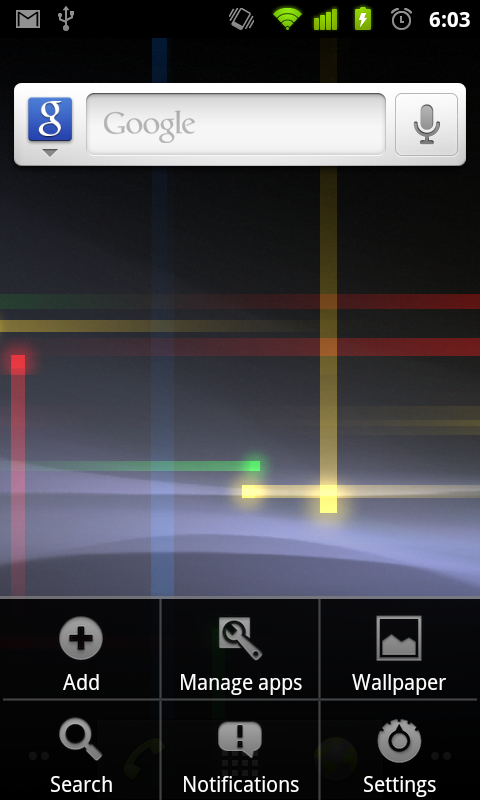
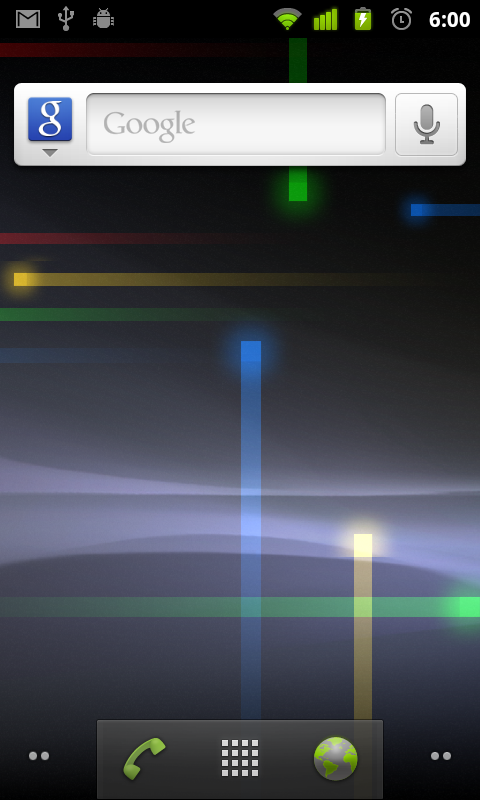
UI refinements for simplicity and speed
The user interface is refined in many ways across the system, making it easier to learn, faster to use, and more power-efficient. A simplified visual theme of colors against black brings vividness and contrast to the notification bar, menus, and other parts of the UI. Changes in menus and settings make it easier for the user to navigate and control the features of the system and device.
Faster, more intuitive text input
The Android soft keyboard is redesigned and optimized for faster text input and editing. The keys themselves are reshaped and repositioned for improved targeting, making them easier to see and press accurately, even at high speeds. The keyboard also displays the current character and dictionary suggestions in a larger, more vivid style that is easier to read.
The keyboard adds the capability to correct entered words from suggestions in the dictionary. As the user selects a word already entered, the keyboard displays suggestions that the user can choose from, to replace the selection. The user can also switch to voice input mode to replace the selection. Smart suggestions let the user accept a suggestion and then return to correct it later, if needed, from the original set of suggestions.
New multitouch key-chording lets the user quickly enter numbers and symbols by pressing Shift+<letter> and ?123+<symbol>, without needing to manually switch input modes. From certain keys, users can also access a popup menu of accented characters, numbers, and symbols by holding the key and sliding to select a character.
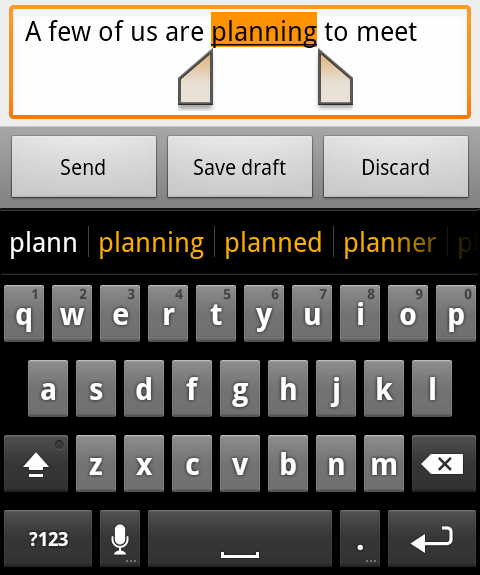
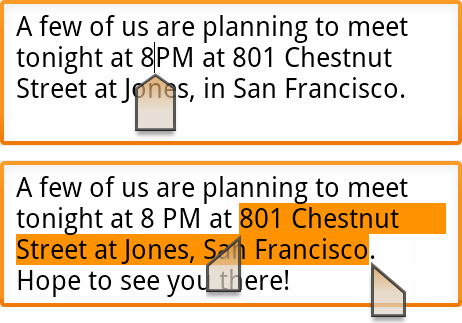
One-touch word selection and copy/paste
When entering text or viewing a web page, the user can quickly select a word by press-hold, then copy to the clipboard and paste. Pressing on a word enters a free-selection mode — the user can adjust the selection area as needed by dragging a set of bounding arrows to new positions, then copy the bounded area by pressing anywhere in the selection area. For text entry, the user can slide-press to enter a cursor mode, then reposition the cursor easily and accurately by dragging the cursor arrow. With both the selection and cursor modes, no use of a trackball is needed.
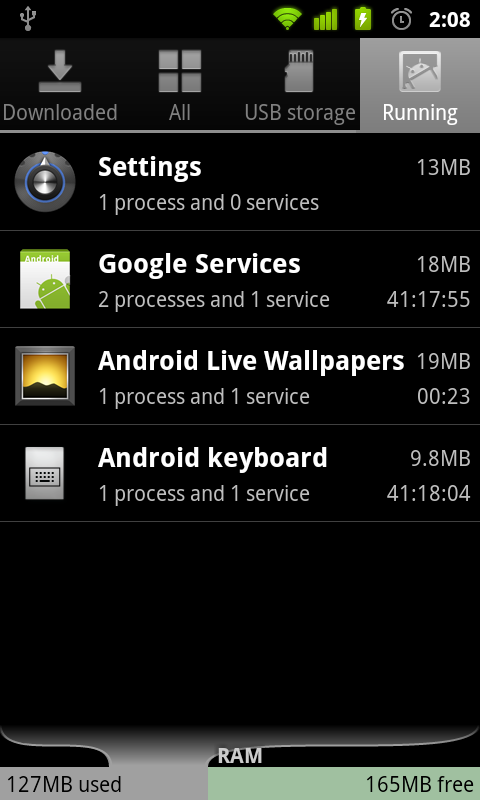
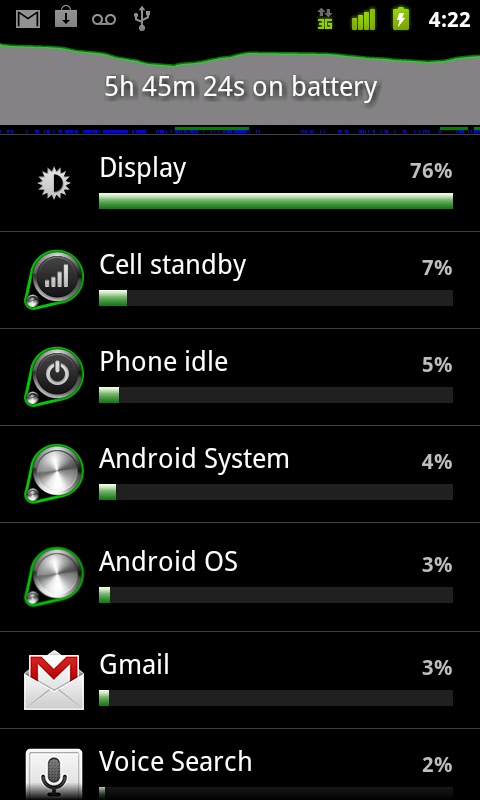
Improved power management
The Android system takes a more active role in managing apps that are keeping the device awake for too long or that are consuming CPU while running in the background. By managing such apps — closing them if appropriate — the system helps ensure best possible performance and maximum battery life.
The system also gives the user more visibility over the power being consumed by system components and running apps. The Application settings provides an accurate overview of how the battery is being used, with details of the usage and relative power consumed by each component or application.
Control over applications
A shortcut to the Manage Applications control now appears in the Options Menu in the Home screen and Launcher, making it much easier to check and manage application activity. Once the user enters Manage Applications, a new Running tab displays a list of active applications and the storage and memory being used by each. The user can read further details about each application and if necessary stop an application or report feedback to its developer.
New ways of communicating, organizing
An updated set of standard applications lets the user take new approaches to managing information and relationships.
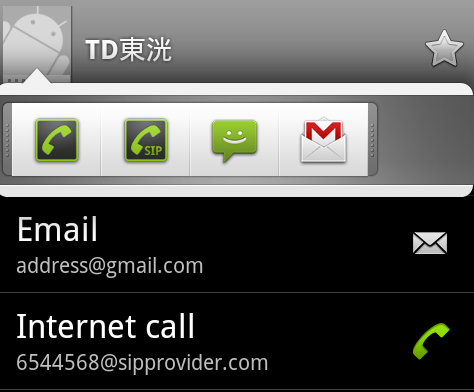
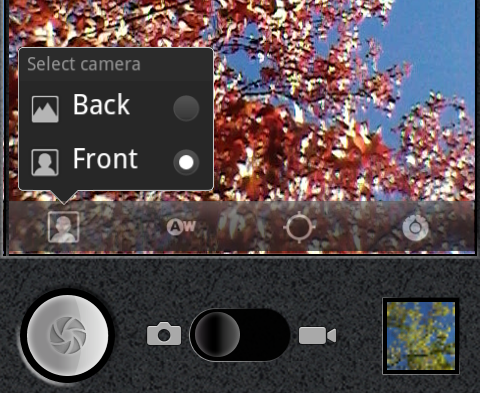
Internet calling
The user can make voice calls over the internet to other users who have SIP accounts. The user can add an internet calling number (a SIP address) to any Contact and can initiate a call from Quick Contact or Dialer. To use internet calling, the user must create an account at the SIP provider of their choice — SIP accounts are not provided as part of the internet calling feature. Additionally, support for the platform's SIP and internet calling features on specific devices is determined by their manufacturers and associated carriers.
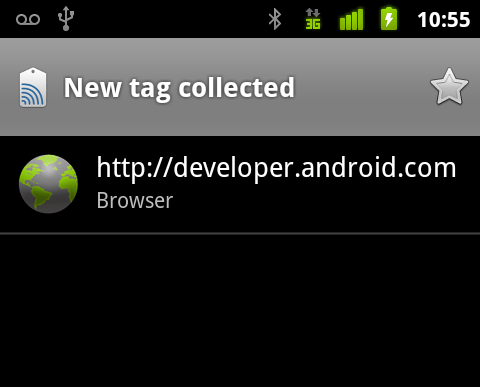
Near-field communications
An NFC Reader application lets the user read and interact with near-field communication (NFC) tags. For example, the user can “touch” or “swipe” an NFC tag that might be embedded in a poster, sticker, or advertisement, then act on the data read from the tag. A typical use would be to read a tag at a restaurant, store, or event and then rate or register by jumping to a web site whose URL is included in the tag data. NFC communication relies on wireless technology in the device hardware, so support for the platform's NFC features on specific devices is determined by their manufacturers.
Downloads management
The Downloads application gives the user easy access to any file downloaded from the browser, email, or another application. Downloads is built on an completely new download manager facility in the system that any other applications can use, to more easily manage and store their downloads.
Camera
The application now lets the user access multiple cameras on the device, including a front-facing camera, if available.
New Developer Features
Android 2.3 delivers a variety of features and APIs that let developers bring new types of applications to the Android platform.
- Enhancements for gaming
- New forms of communication
- Rich multimedia
Enhancements for gaming
Performance
Android 2.3 includes a variety of improvements across the system that make common operations faster and more efficient for all applications. Of particular interest to game developers are:
- Concurrent garbage collector — The Dalivik VM introduces a new, concurrent garbage collector that minimizes application pauses, helping to ensure smoother animation and increased responsiveness in games and similar applications.
- Faster event distribution — The plaform now handles touch and keyboard events faster and more efficiently, minimizing CPU utilization during event distribution. The changes improve responsiveness for all applications, but especially benefit games that use touch events in combination with 3D graphics or other CPU-intensive operations.
- Updated video drivers — The platform uses updated third-party video drivers that improve the efficiency of OpenGL ES operations, for faster overall 3D graphics performance.
Native input and sensor events
Applications that use native code can now receive and process input and sensor events directly in their native code, which dramatically improves efficiency and responsiveness.
Native libraries exposed by the platform let applications handle the same types of input events as those available through the framework. Applications can receive events from all supported sensor types and can enable/disable specific sensors and manage event delivery rate and queueing.
Gyroscope and other new sensors, for improved 3D motion processing
Android 2.3 adds API support for several new sensor types, including gyroscope, rotation vector, linear acceleration, gravity, and barometer sensors. Applications can use the new sensors in combination with any other sensors available on the device, to track three-dimensional device motion and orientation change with high precision and accuracy. For example, a game application could use readings from a gyroscope and accelerometer on the device to recognize complex user gestures and motions, such as tilt, spin, thrust, and slice.
Open API for native audio
The platform provides a software implementation of Khronos OpenSL ES, a standard API that gives applications access to powerful audio controls and effects from native code. Applications can use the API to manage audio devices and control audio input, output, and processing directly from native code.
Native graphics management
The platform provides an interface to its Khronos EGL library, which lets applications manage graphics contexts and create and manage OpenGL ES textures and surfaces from native code.
Native access to Activity lifecycle, window management
Native applications can declare a new type of Activity class,
NativeActivity whose lifecycle callbacks are implemented directly in native code. The NativeActivity and its underlying native code run in the system just as do other Activities — they run in the application's system process and execute on the application's main UI thread, and they receive the same lifecycle callbacks as do other Activities.
The platform also exposes native APIs for managing windows, including the ability to lock/unlock the pixel buffer to draw directly into it. Through the API, applications can obtain a native window object associated with a framework Surface object and interact with it directly in native code.
Native access to assets, storage
Applications can now access a native Asset Manager API to retrieve application assets directly from native code without needing to go through JNI. If the assets are compressed, the platform does streaming decompression as the application reads the asset data. There is no longer a limit on the size of compressed
.apk assets that can be read.
Additionally, applications can access a native Storage Manager API to work directly with OBB files downloaded and managed by the system. Note that although platform support for OBB is available in Android 2.3, development tools for creating and managing OBB files will not be available until early 2011.
Robust native development environment
The Android NDK (r5 or higher) provides a complete set of tools, toolchains, and libraries for developing applications that use the rich native environment offered by the Android 2.3 platform.
New forms of communication
Internet telephony
Developers can now add SIP-based internet telephony features to their applications. Android 2.3 includes a full SIP protocol stack and integrated call management services that let applications easily set up outgoing and incoming voice calls, without having to manage sessions, transport-level communication, or audio record or playback directly.
Support for the platform's SIP and internet calling features on specific devices is determined by their manufacturers and associated carriers.
Near Field Communications (NFC)
The platform's support for Near Field Communications (NFC) lets developers get started creating a whole new class of applications for Android. Developers can create new applications that offer proximity-based information and services to users, organizations, merchants, and advertisers.
Using the NFC API, applications can read and respond to NFC tags “discovered” as the user “touches” an NFC-enabled device to elements embedded in stickers, smart posters, and even other devices. When a tag of interest is collected, applications can respond to the tag, read messages from it, and then store the messages, prompting the user as needed.
Starting from Android 2.3.3, applications can also write to tags and set up peer-to-peer connections with other NFC devices.
NFC communication relies on wireless technology in the device hardware, so support for the platform's NFC features on specific devices is determined by their manufacturers.
Rich multimedia
Mixable audio effects
A new audio effects API lets developers easily create rich audio environments by adding equalization, bass boost, headphone virtualization (widened soundstage), and reverb to audio tracks and sounds. Developers can mix multiple audio effects in a local track or apply effects globally, across multiple tracks.
Support for new media formats
The platform now offers built-in support for the VP8 open video compression format and the WebM open container format. The platform also adds support for AAC encoding and AMR wideband encoding (in software), so that applications can capture higher quality audio than narrowband.
Access to multiple cameras
The Camera API now lets developers access any cameras that are available on a device, including a front-facing camera. Applications can query the platform for the number of cameras on the device and their types and characteristics, then open the camera needed. For example, a video chat application might want to access a front-facing camera that offers lower-resolution, while a photo application might prefer a back-facing camera that offers higher-resolution.
New Platform Technologies
Media Framework
- New media framework fully replaces OpenCore, maintaining all previous codec/container support for encoding and decoding.
- Integrated support for the VP8 open video compression format and the WebM open container format
- Adds AAC encoding and AMR wideband encoding
Linux Kernel
- Upgraded to 2.6.35
Networking
- SIP stack, configurable by device manufacturer
- Support for Near Field Communications (NFC), configurable by device manufacturer
- Updated BlueZ stack
Dalvik runtime
- Dalvik VM:
- Concurrent garbage collector (target sub-3ms pauses)
- Adds further JIT (code-generation) optimizations
- Improved code verification
- StrictMode debugging, for identifying performance and memory issues
- Core libraries:
- Expanded I18N support (full worldwide encodings, more locales)
- Faster Formatter and number formatting. For example, float formatting is 2.5x faster.
- HTTP responses are gzipped by default. XML and JSON API response sizes may be reduced by 60% or more.
- New collections and utilities APIs
- Improved network APIs
- Improved file read and write controls
- Updated JDBC
- Updates from upstream projects:
- OpenSSL 1.0.0a
- BouncyCastle 1.45
- ICU 4.4
- zlib 1.2.5
Android 2.3.3 APIs
API Level: 10- Android 2.3.3 is a small feature release that adds several improvements and APIs to the Android 2.3 platform.
- For developers, the Android 2.3.3 platform is available as a downloadable component for the Android SDK. The downloadable platform includes an Android library and system image, as well as a set of emulator skins and more. To get started developing or testing against Android 2.3.3, use the Android SDK Manager to download the platform into your SDK.
- API Overview
- The sections below provide a technical overview of what's new for developers in 2.3.3, including new features and changes in the framework API since the previous version.
- Near Field Communications (NFC)
- Android 2.3.3 provides improved and extended support for NFC, to allow applications to interact with more types of tags in new ways.
- A new, comprehensive set of APIs give applications read and write access to a wider range of standard tag technologies, including:
- NFC-A (ISO 14443-3A)
- NFC-B (ISO 14443-3B)
- NFC-F (JIS 6319-4)
- NFC-V (ISO 15693)
- ISO-DEP (ISO 14443-4)
- MIFARE Classic
- MIFARE Ultralight
- NFC Forum NDEF tags
- The platform also provides a limited peer-to-peer communication protocol and API. Foreground Activities can use the API to register an NDEF message that will get pushed to other NFC devices when they connect.
- Advanced tag dispatching now gives applications more control over how and when they are launched, when an NFC tag is discovered. Previously, the platform used a single-step intent dispatch to notify interested applications that a tag was discovered. The platform now uses a four-step process that enables the foreground application to take control of a tag event before it is passed to any other applications (android.nfc.NfcAdapter.enableForegroundDispatch()). The new dispatch process also lets apps listen for specific tag content and tag technologies, based on two new intent actions — android.nfc.action.NDEF_DISCOVERED and android.nfc.action.TECH_DISCOVERED.
- The NFC API is available in the android.nfc and android.nfc.tech packages. The key classes are:
- NfcAdapter, which represents the NFC hardware on the device.
- NdefMessage, which represents an NDEF data message, the standard format in which "records" carrying data are transmitted between devices and tags. An NDEF message certain many NDEF records of different types. Applications can receive these messages from NDEF_DISCOVERED, TECH_DISCOVERED, or TAG_DISCOVERED Intents.
- NdefRecord, delivered in an NdefMessage, which describes the type of data being shared and carries the data itself.
- Tag, which represents a tag scanned by the device. Multiple types of tags are supported, based on the underlying tag technology.
- TagTechnology, an interface that gives applications access to tag properties and I/O operations based on the technologies present in the tag. For a full list of tag technologies supported in Android 2.3.3, see android.nfc.tech.
- NFC communication relies on wireless technology in the device hardware, and is not present in all Android devices. Android devices that do not support NFC will return a null object when getDefaultAdapter(Context) is called, and context.getPackageManager().hasSystemFeature(PackageManager.FEATURE_NFC) will return false. The NFC API is always present, however, regardless of underlying hardware support.
- To use the NFC API, applications must request permission from the user by declaring <uses-permission android:name="android.permission.NFC"> in their manifest files.
- Additionally, developers can request filtering on Google Play, such that their applications are not discoverable to users whose devices do not support NFC. To request filtering, add <uses-feature android:name="android.hardware.nfc" android:required="true"> to the application's manifest.
- For more information, read the NFC developer guide.
- Bluetooth
- Android 2.3.3 adds platform and API support for Bluetooth nonsecure socket connections. This lets applications communicate with simple devices that may not offer a UI for authentication. See createInsecureRfcommSocketToServiceRecord(java.util.UUID) and listenUsingInsecureRfcommWithServiceRecord(java.lang.String, java.util.UUID) for more information.
- Graphics
- A new BitmapRegionDecoder class lets applications decode a rectangle region from an image. The API is particularly useful when an original image is large and and the application only need parts of the image.
- A new inPreferQualityOverSpeed field in BitmapFactory.Options allows applications to use a more accurate but slightly slower IDCT method in JPEG decode. This in turn improves the quality of the reconstructed image.
- Media framework
- A new MediaMetadataRetriever class provides a unified interface for retrieving frame and metadata from an input media file.
- MediaRecorder.AudioEncoder and MediaRecorder.OutputFormat include new fields for specifying AMR Wideband and AAC formats.
- Speech recognition
- The speech-recognition API includes new constants to let you manage voice search results in new ways. Although the new constants are not needed for normal use of speech recognition, you could use them to offer a different view of voice search results in your application. For information, see RecognizerResultsIntent.
- API Level
- The Android 2.3.3 platform delivers an updated version of the framework API. The Android 2.3.3 API is assigned an integer identifier — 10 — that is stored in the system itself. This identifier, called the "API Level", allows the system to correctly determine whether an application is compatible with the system, prior to installing the application.
- To use APIs introduced in Android 2.3.3 in your application, you need compile the application against the Android library that is provided in the Android 2.3.3 SDK platform. Depending on your needs, you might also need to add an android:minSdkVersion="10" attribute to the <uses-sdk> element in the application's manifest. If your application is designed to run only on Android 2.3 and higher, declaring the attribute prevents the application from being installed on earlier versions of the platform
Android 2.3.4 APIs
API Level: 10
Android 2.3.4 is a maintenance release that adds several bug fixes and patches to the Android 2.3 platform, without any API changes from Android 2.3.3. Additionally, Android 2.3.4 brings support for the Open Accessory API to mobile devices, through the optional Open Accessory Library.
For developers, the Android 2.3.4 platform is available as a downloadable component for the Android SDK. The downloadable platform includes an Android library and system image, as well as a set of emulator skins and more. To get started developing or testing against Android 2.3.4, use the Android SDK Manager to download the platform into your SDK.
API Overview
Android 2.3.4 provides the same framework API to applications as Android 2.3.3 (API level 10). For a summary of the API, see the Android 2.3.3 version notes.
Open Accessory Library
Open Accessory is a new capability for integrating connected peripherals with applications running on the platform. The capability is based on a USB (Universal Serial Bus) stack built into the platform and an API exposed to applications. Peripherals that attach to Android-powered devices as accessories connect as USB hosts.
Open Accessory is introduced in Android 3.1 (API level 12), but is made available to devices running Android 2.3.4 by means of an optional external library, the Open Accessory Library. The library exposes a framework API that lets applications discover, communicate with, and manage a variety of device types connected over USB. It also provides the implementation of the API against parts of the Android platform that are not directly exposed to applications in Android 2.3.4.
The Open Accessory Library is optional on any given device. Device manufacturers may choose whether to include the Open Accessory Library in their products or exclude it. The library is forward-compatible with Android 3.1, so applications developed against Android 2.3.4 will run properly on devices running Android 3.1, if those devices support USB accessories.
The API provided by the Open Accessory Library is based on the Open Accessory API provided in Android 3.1. In most areas, you can use the same techniques and APIs. However, developing for the Open Accessory Library on Android 2.3.4 differs from the standard USB API in these ways:
Obtaining a UsbManager object — To obtain a UsbManager object when using the add-on library, use the helper method getInstance() rather than getSystemService() For example:
UsbManager manager = UsbManager.getInstance(this);
Obtaining a UsbAccessory from a filtered intent — When you filter for a connected device or accessory with an intent filter, the UsbAccessory object is contained inside the intent that is passed to your application. If you are using the add-on library, you can get the UsbAccessory object in the following manner:
UsbAccessory accessory = UsbManager.getAccessory(intent)
No USB host support — Android 2.3.4 and the Open Accessory Library do not support USB host mode (for example, through UsbDevice), although USB host mode is supported in Android 3.1. An Android-powered device running Android 2.3.4 can not function as a USB host. The library enables the Android-powered device to function as a peripheral only, with the connected accessory functioning as USB host (through UsbAccessory).
To develop apps using the Open Accessory Library, you need:
The latest version of the Android SDK tools
The latest version of the Google APIs add-on, which includes the library itself (for linking)
An actual hardware device running Android 2.3.4 (or Android 3.1) with USB accessories support, for runtime testing against connected devices
For a full discussion of how to develop applications that interact with USB accessories, please see the related developer documentation.
Additionally, developers can request filtering on Google Play, such that their applications are not available to users whose devices do not provide the appropriate accessory support. To request filtering, add the element below to the application manifest:
<uses-feature
android:name="android.hardware.usb.accessory"
android:required="true">
API Level
The Android 2.3.4 platform does not increment the API level — it uses the same API level as Android 2.3.3, API level 10.
To use APIs introduced in API level 10 in your application, you need compile the application against the Android library that is provided in the latest version of the Google APIs Add-On, which also includes the Open Accessory Library.
Depending on your needs, you might also need to add an android:minSdkVersion="10" attribute to the <uses-sdk> element in the application's manifest. If your application is designed to run only on Android 2.3.3 and higher, declaring the attribute prevents the application from being installed on earlier versions of the platform
No comments:
Post a Comment